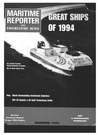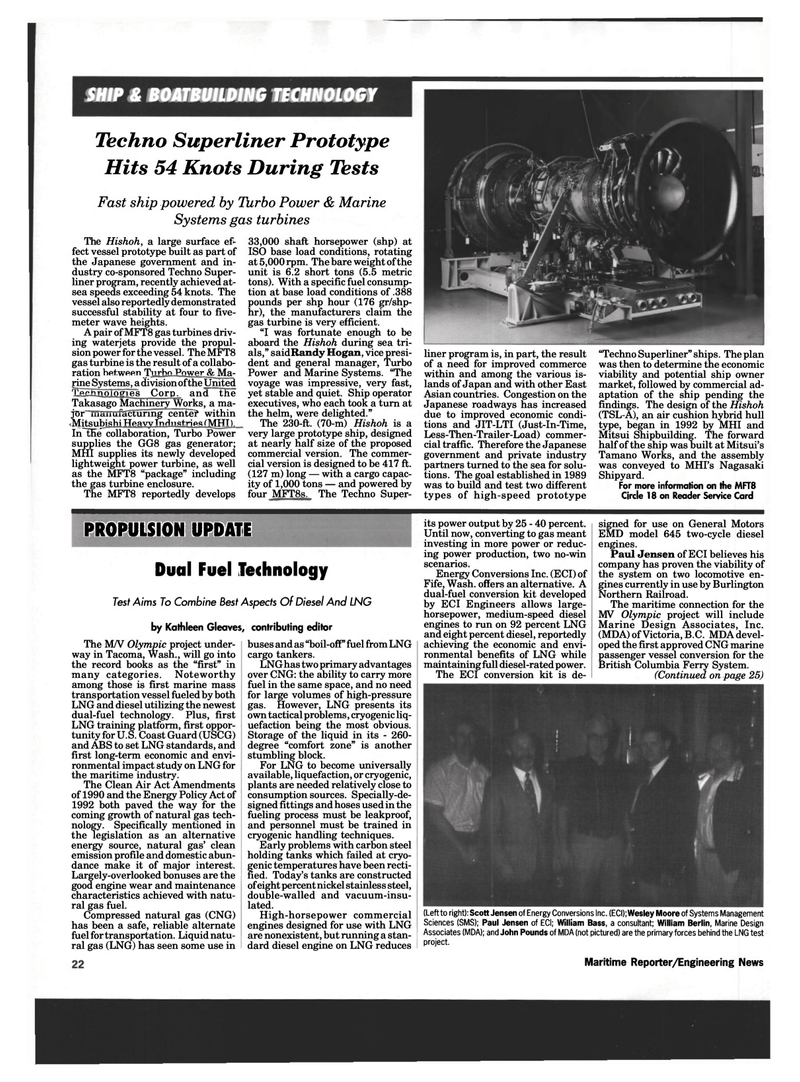
Page 20: of Maritime Reporter Magazine (December 1994)
Read this page in Pdf, Flash or Html5 edition of December 1994 Maritime Reporter Magazine
Techno Superliner Prototype
Hits 54 Knots During Tests
Fast ship powered by Turbo Power & Marine
Systems gas turbines
The Hishoh, a large surface ef- fect vessel prototype built as part of the Japanese government and in- dustry co-sponsored Techno Super- liner program, recently achieved at- sea speeds exceeding 54 knots. The vessel also reportedly demonstrated successful stability at four to five- meter wave heights.
A pair of MFT8 gas turbines driv- ing waterjets provide the propul- sion power for the vessel. TheMFT8 gas turbine is the result of a collabo- ration between Tprhn Power & Ma- rine Systems, a division of the United
Technologies Corp. an3 the!
Takasago Machinery Works, a ma- jor manufacturing cente? within .Mitsubishi HeavyIndustries (MHI).
InTKef collaboration, Turbo Power supplies the GG8 gas generator;
MHI supplies its newly developed lightweight power turbine, as well as the MFT8 "package" including the gas turbine enclosure.
The MFT8 reportedly develops 33,000 shaft horsepower (shp) at
ISO base load conditions, rotating at 5,000 rpm. The bare weight of the unit is 6.2 short tons (5.5 metric tons). With a specific fuel consump- tion at base load conditions of .388 pounds per shp hour (176 gr/shp- hr), the manufacturers claim the gas turbine is very efficient. "I was fortunate enough to be aboard the Hishoh during sea tri- als," saidRandy Hogan, vice presi- dent and general manager, Turbo
Power and Marine Systems. "The voyage was impressive, very fast, yet stable and quiet. Ship operator executives, who each took a turn at the helm, were delighted."
The 230-ft. (70-m) Hishoh is a very large prototype ship, designed at nearly half size of the proposed commercial version. The commer- cial version is designed to be 417 ft. (127 m) long — with a cargo capac- ity of 1,000 tons — and powered by four MFT8s. The Techno Super- "Techno Superliner" ships. The plan was then to determine the economic viability and potential ship owner market, followed by commercial ad- aptation of the ship pending the findings. The design of the Hishoh (TSL-A), an air cushion hybrid hull type, began in 1992 by MHI and
Mitsui Shipbuilding. The forward half of the ship was built at Mitsui's
Tamano Works, and the assembly was conveyed to MHI's Nagasaki
Shipyard.
For more information on the MFT8
Circle 18 on Reader Service Card liner program is, in part, the result of a need for improved commerce within and among the various is- lands of Japan and with other East
Asian countries. Congestion on the
Japanese roadways has increased due to improved economic condi- tions and JIT-LTI (Just-In-Time,
Less-Then-Trailer-Load) commer- cial traffic. Therefore the Japanese government and private industry partners turned to the sea for solu- tions. The goal established in 1989 was to build and test two different types of high-speed prototype
PROPULSION UPDATE
Dual Fuel Technology
Test Aims To Combine Best Aspects Of Diesel And LNG by Kathleen Gleaves, contributing editor
The M/V Olympic project under- way in Tacoma, Wash., will go into the record books as the "first" in many categories. Noteworthy among those is first marine mass transportation vessel fueled by both
LNG and diesel utilizing the newest dual-fuel technology. Plus, first
LNG training platform, first oppor- tunity for U.S. Coast Guard (USCG) and ABS to set LNG standards, and first long-term economic and envi- ronmental impact study on LNG for the maritime industry.
The Clean Air Act Amendments of 1990 and the Energy Policy Act of 1992 both paved the way for the coming growth of natural gas tech- nology. Specifically mentioned in the legislation as an alternative energy source, natural gas' clean emission profile and domestic abun- dance make it of major interest.
Largely-overlooked bonuses are the good engine wear and maintenance characteristics achieved with natu- ral gas fuel.
Compressed natural gas (CNG) has been a safe, reliable alternate fuel for transportation. Liquid natu- ral gas (LNG) has seen some use in 26D buses and as "boil-off" fuel from LNG cargo tankers.
LNG has two primary advantages over CNG: the ability to carry more fuel in the same space, and no need for large volumes of high-pressure gas. However, LNG presents its own tactical problems, cryogenic liq- uefaction being the most obvious.
Storage of the liquid in its - 260- degree "comfort zone" is another stumbling block.
For LNG to become universally available, liquefaction, or cryogenic, plants are needed relatively close to consumption sources. Specially-de- signed fittings and hoses used in the fueling process must be leakproof, and personnel must be trained in cryogenic handling techniques.
Early problems with carbon steel holding tanks which failed at cryo- genic temperatures have been recti- fied. Today's tanks are constructed of eight percent nickel stainless steel, double-walled and vacuum-insu- lated.
High-horsepower commercial engines designed for use with LNG are nonexistent, but running a stan- dard diesel engine on LNG reduces its power output by 25 - 40 percent.
Until now, converting to gas meant investing in more power or reduc- ing power production, two no-win scenarios.
Energy Conversions Inc. (ECI) of
Fife, Wash, offers an alternative. A dual-fuel conversion kit developed by ECI Engineers allows large- horsepower, medium-speed diesel engines to run on 92 percent LNG and eight percent diesel, reportedly achieving the economic and envi- ronmental benefits of LNG while maintaining full diesel-rated power.
The ECI conversion kit is de- signed for use on General Motors
EMD model 645 two-cycle diesel engines.
Paul Jensen of ECI believes his company has proven the viability of the system on two locomotive en- gines currently in use by Burlington
Northern Railroad.
The maritime connection for the
MV Olympic project will include
Marine Design Associates, Inc. (MDA) of Victoria, B.C. MDA devel- oped the first approved CNG marine passenger vessel conversion for the
British Columbia Ferry System. (Continued on page 25) (Left to right): Scott Jensen of Energy Conversions Inc. (ECI); Wesley Moore of Systems Management
Sciences (SMS); Paul Jensen of ECI; William Bass, a consultant; William Berlin, Marine Design
Associates (MDA); and John Pounds of MDA (not pictured) are the primary forces behind the LNG test project.
Maritime Reporter/Engineering News

 19
19

 21
21
